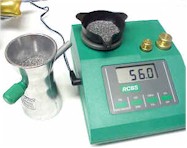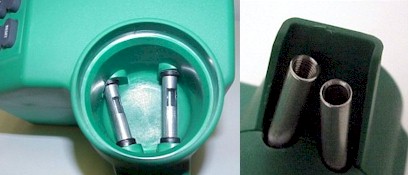 Within Part I of this saga, I explained how I was able to replace an excellent mechanical scale with a much slower, yet no more accurate electronic device, and at only twice the price. Where else, but Real Guns, could you find such unbridled wisdom ?
Within Part I of this saga, I explained how I was able to replace an excellent mechanical scale with a much slower, yet no more accurate electronic device, and at only twice the price. Where else, but Real Guns, could you find such unbridled wisdom ?
In Part II, I’m going double down and plunging ahead into yet more uncharted territory because, as we all know, the best way to recover from a bad investment is to make a further investment; enter the Powdermaster Electronic Powder Dispenser.
 The Powdermaster dispenser and Powder Pro scale are designed to work in unison; the electronic scale keeps track of the powder weight being dispensed and provides feedback to the dispenser. The dispenser reads this data and modulates the amount of powder it is dispensing to the scale. To the right, the two units are in operating position. The canister on the dispenser contains a full pound of Hodgdon H1000 smokeless powder.
The Powdermaster dispenser and Powder Pro scale are designed to work in unison; the electronic scale keeps track of the powder weight being dispensed and provides feedback to the dispenser. The dispenser reads this data and modulates the amount of powder it is dispensing to the scale. To the right, the two units are in operating position. The canister on the dispenser contains a full pound of Hodgdon H1000 smokeless powder.
The two devices communicate digitally via an infrared port ( a small hole ) on the side of each units. When you slide the scale under the dispenser spout, the ports come into alignment. While powder dispensing is in progress, the infrared bulb/sensor combination exchanges digital code.
Both units have sturdy molded plastic housings with a combination of membrane and keypad controls. The hopper appears to be made from inexpensive soft plastic that builds a static charge like crazy, causing powder granules to dangle from the side walls as the hopper empties. In fact, emptying the hopper after use is somewhat of a pain in the neck.
The dispenser price through Internet discounters or via mail order is about $180, the scale runs about $175 for a total of $355 for the system. In other words, a little less than a Marlin Guide Gun, or a Ruger Bisley in .45 Colt. This is more than a casual expenditure.
 The dispenser is easy to set up and use. In the picture on the left, three of the four indicator lights are illuminated next to the key pad. The first is “scale”, it blinks until communication is established between the two units, which is accomplished by switching the scale’s port on and making sure the two ports align with one another.
The dispenser is easy to set up and use. In the picture on the left, three of the four indicator lights are illuminated next to the key pad. The first is “scale”, it blinks until communication is established between the two units, which is accomplished by switching the scale’s port on and making sure the two ports align with one another.
The next light is “calibrate”. Once communication between the scale and dispenser is established, the dispenser calibrates itself by metering powder, checking the scales reading, metering some more, and continuing in this manner until the dispenser understands the scales calibration and response times to keeping up with changes in dispensed weight. As an example, the dispenser learns to anticipate a 5 second lag in the scale’s readings, so the dispenser stops feeding at a slightly lighter scale reading, anticipating the scale will catch up and the final reading will be correct. The third light is “Memory”. After calibration, the amount of desired charge is entered into the keypad, the memory light becomes illuminated, the “Dispense” button is depressed, and the “Dispense” light remains illuminated until the charge is completely dispensed into the scale.

With the clear plastic hopper removed, to the left, the two driven metering tubes are visible. On the right is an underside view of the dispensing snout that hangs out over the powder scale pan. The tube on the right is the high speed/high volume feeder, the tube on the left is the low speed/low volume feeder. When “Dispense” is selected from the dispenser keypad, the right tube goes into operation, dumping multiple whole grain powder increments. As the scale feeds back to the dispenser it is nearing the specified weight, the right feeder shuts down and the left begins to slowly meter in one tenth grain increments. It’s just like a manual powder trickler, only with the machine driving the tube, and the computer metering and keeping track of progress.
Emptying the hopper at the end of a loading session requires three or four hands, unfortunately, under the control of one brain. The hopper cap is not a press fit, so it is not retained when the entire dispenser is inverted for emptying, and must be held in place. Powder hangs onto the hopper as a result of a significant static charge, and you need to continually flip and shake the dispenser to get the powder out of the feed tubes as well as the hopper.
Conclusion
The scale and electronic combo are interesting, and fun to watch in operation for at least one or two cycles, at which point most people would become terminally bored and pass out. This is a sloooow operation. In timing metering of several types of powder, ball and cylindrical in shape, it took a full minute to meter 90 grains. Because a great deal of the metering overhead is spent trickling the last few tenths of grains, metering smaller charges does not take proportionally shorter periods of time. Rather than 50 grains taking 36 seconds, it took 50 seconds, with 12 grains taking 20 seconds rather than 8 seconds. I could hardly see myself taking an hour to measure and charge 60 rounds of .243 ammo.
Best case, this measuring system would work great when working up new loads. It’s easy to punch in 50 grains, then increment the next several test cartridges to whatever level is desired. The scale can make those full or partial grain types of adjustments very easily and accurately. So I thought I would use the equipment for my largest cases where mechanical dispensers couldn’t be used, which takes us to what I believe is a fatal limitation. The dispenser can only be set to dispense a maximum charge of 99.99 grains. It makes absolutely no sense to me why RCBS would limit a dispenser to a fraction of the scale’s capacity, particularly at a time when very large capacity cartridges are seeing increased popularity.
For a combined cost of $355 to $400, I’d skip both the electronic scale and the dispenser, and stay with a decent mechanical scale and metering system. The electronic versions are no more accurate, are much slower in operation, are more limited in capability, and much more expensive. Yikes ! Save the bucks and buy one of those neato lever action guide guns.
This product has been replaced by the RCBS ChargeMaster.
Thanks,
Joe

Email Notification